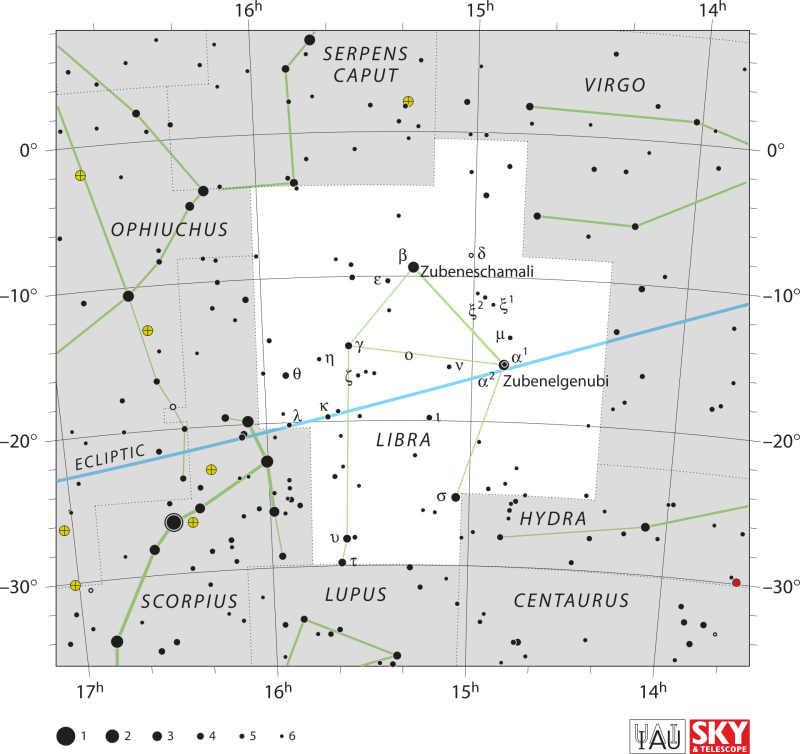
Look for the constellation Libra the Scales on Northern Hemisphere summer evenings (Southern Hemisphere winter evenings). It’s not the most flashy constellation of the zodiac. But its two brightest stars have the best star names: Zubenelgenubi and Zubeneschamali. The names rhyme with Obi-Wan Kenobi of “Star Wars.”
Here’s how to pronounce Zubeneschamali
Here’s how to pronounce Zubenelgenubi
You can find Libra easily in a dark sky. On the chart below, notice Libra’s place with respect to another even brighter star, red Antares, Heart of the Scorpion in the constellation Scorpius. The Scorpion has a distinctive shape. And Antares is noticeable for being bright, and red, and for twinkling fiercely. Find Antares … and Libra will be nearby.

Libra and the ecliptic
Libra is a constellation of the zodiac. So you know to look for it along the sun’s path across our sky. This path is the ecliptic. As seen from Earth, the sun passes in front of the constellation Libra from about October 30 until November 22 every year.
Libra’s star Zubenelgenubi sits almost exactly on the ecliptic. At present, the sun has its annual conjunction with Zubenelgenubi on or near November 7, or about midway between the September equinox and the December solstice.
But, as with all things heavenly, the conjunction date of the sun and Zubenelgenubi changes over the long course of time.
More than 3,000 years ago, the sun and Zubenelgenubi were in conjunction on the Northern Hemisphere’s autumnal equinox (Southern Hemisphere’s spring equinox). Over 3,000 years into the future, the sun and Zubenelgenubi will be in conjunction on the December solstice (Northern Hemisphere’s winter solstice or Southern Hemisphere’s summer solstice).
Regardless of which constellation provides a backdrop for the sun on the September equinox, the sun is said to be at the first point of the sign Libra when it the crosses the celestial equator going from north to south.
Read more: what’s the difference between a sign and a constellation?

Libra in history and myth
Several thousand years ago – around 2,000 BCE – the ancient Babylonians apparently associated this constellation with scales or a balance. Quite possibly, they made this association because the sun on the autumnal equinox shone in front of the stars of Libra at that time. It’s at the equinox that the world realizes its seasonal and temporal balance between the extremes of heat and cold, and with day and night of equal length all over the globe. Metaphorically, Libra the Scales serves as an age-old symbol of divine justice, harmony and balance.
In contrast to their Babylonian forebears, the ancient Greeks seemed to regard Libra as the outstretched claws of the constellation Scorpius the Scorpion. In fact, the names for Libra’s two brightest stars are Arabic terms that hearken back to these olden times when Scorpius reigned as a double or super constellation. Zubenelgenubi translates into the southern claw of the Scorpion and Zubeneschamali into the northern claw of the Scorpion.
The Romans, though inheriting much of the Greek tradition, again revived Libra as the only inanimate constellation of the zodiac. In Roman thought, the constellation Virgo is the embodiment of Astraea, the Starry Goddess, holding Libra, the Scales of Justice.
Astrologers regard Libra as the second air sign, ruled over by the planet Venus. Although astronomy and astrology have been intertwined historically, they are now regarded as separate disciplines. Astrology assumes the positions of heavenly bodies have certain influences over human affairs which most modern-day astronomers regard as unfounded.

More constellations of the zodiac
Taurus the Bull
Gemini the Twins, home to 2 bright stars
Cancer the Crab and its Beehive Cluster
Leo the Lion and its backward question mark
Virgo the Maiden in northern spring skies
Libra the Scales, a zodiacal constellation
Scorpius, a summertime delight
Sagittarius the Archer and its famous Teapot
Capricornus the Sea-goat has an arrowhead shape
Aquarius? Here’s your constellation
Pisces the Fish, 1st constellation of the zodiac
Say hello to Aries the Ram
Born under the sign of Ophiuchus?
Bottom line: Find the zodiacal constellation Libra the Scales in the evening sky during Northern Hemisphere summer (Southern Hemisphere winter) near the bright red star Antares.











